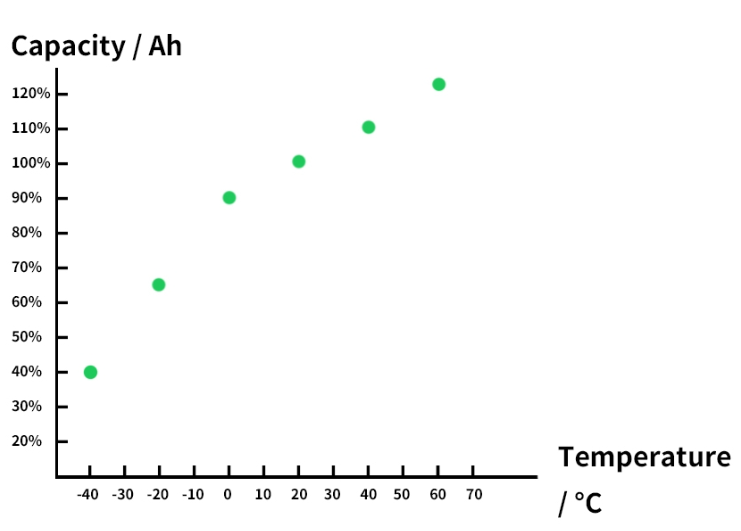What Do You Think of LiFePO4 Temperature Range?
The LiFePO4 (Lithium Iron Phosphate) battery temperature range is crucial for its performance and longevity. Ideally, these batteries operate best between 20°C to 30°C (68°F to 86°F). Deviating from this range can lead to reduced capacity, efficiency, and potential safety hazards.
What is the optimal temperature range for LiFePO4 batteries?
The optimal operating temperature range for LiFePO4 batteries is typically between 20°C to 30°C (68°F to 86°F). Within this range, the batteries can deliver their full rated capacity with minimal degradation. Operating outside this range, especially in extreme heat or cold, can adversely affect performance and lifespan.
| Temperature Range | Description |
|---|---|
| Optimal | 20°C to 30°C (68°F to 86°F) |
| Charging | 0°C to 50°C (32°F to 122°F) |
| Discharging | -20°C to 60°C (-4°F to 140°F) |
How do temperature extremes affect LiFePO4 battery performance?
Temperature extremes can significantly impact the performance of LiFePO4 batteries:
- High Temperatures: Above 45°C (113°F), the battery may experience accelerated self-discharge and reduced capacity. Prolonged exposure can lead to thermal runaway, a serious safety risk.
- Low Temperatures: Below 0°C (32°F), battery capacity decreases, and internal resistance increases, leading to reduced output. At temperatures around -20°C (-4°F), capacity can drop to about 60% of its rated value.
| Temperature Effect | High Temperatures | Low Temperatures |
|---|---|---|
| Capacity Impact | Reduced capacity; risk of thermal runaway | Decreased capacity; increased resistance |
| Performance | Accelerated self-discharge | Limited output |
What are the recommended charging and discharging temperatures for LiFePO4 batteries?
For optimal performance, follow these recommendations:
- Charging Temperature: Ideally between 0°C to 50°C (32°F to 122°F). Charging at lower temperatures can lead to lithium plating, which damages the battery.
- Discharging Temperature: Safe operational range is from -20°C to 60°C (-4°F to 140°F). For best results, discharge within 0°C to 45°C (32°F to 113°F).
| Charging/Discharging | Recommended Temperature Range |
|---|---|
| Charging | 0°C to 50°C (32°F to 122°F) |
| Discharging | -20°C to 60°C (-4°F to 140°F) |
How does temperature impact LiFePO4 battery capacity?
Temperature has a direct correlation with the capacity of LiFePO4 batteries:
- At optimal temperatures, these batteries achieve their rated capacity.
- As temperatures drop below freezing, capacity decreases significantly; at around -20°C, they may only deliver about 40% of their rated capacity.
- Conversely, at elevated temperatures around 40°C, they can exceed their rated capacity slightly due to increased chemical activity.
| Temperature Effect | Capacity Output |
|---|---|
| Optimal | Full rated capacity |
| Cold | ~40% at -20°C |
| Warm | Up to ~120% at 40°C |
What precautions should be taken regarding temperature management?
To ensure safe operation and longevity of your LiFePO4 batteries, consider these precautions:
- Monitor Temperature Regularly: Use thermal monitoring systems when operating in extreme conditions.
- Insulate Batteries: In cold weather, use insulation materials or heating pads.
- Avoid Direct Sunlight: In hot climates, shield batteries from direct sunlight.
- Store Properly: Keep batteries in a controlled environment within recommended temperature ranges.
| Precaution | Description |
|---|---|
| Monitor Temperature | Use thermal sensors for real-time monitoring |
| Insulate Batteries | Protect against cold with insulation |
| Avoid Sunlight | Use shading or covers in hot conditions |
| Store Properly | Maintain a controlled environment |
How can you maintain optimal temperatures for LiFePO4 batteries?
To maintain optimal temperatures for your LiFePO4 batteries, follow these tips:
- Use Thermal Management Systems: Employ active cooling or heating systems as needed.
- Regular Maintenance Checks: Inspect battery health and connections frequently.
- Store Batteries Indoors: Avoid extreme outdoor conditions by storing them in a climate-controlled environment.
- Charge in Optimal Conditions: Whenever possible, charge your batteries within the recommended temperature ranges.
| Maintenance Method | Description |
|---|---|
| Thermal Management | Use cooling/heating systems as necessary |
| Regular Checks | Inspect health and connections frequently |
| Indoor Storage | Keep in climate-controlled environments |
| Optimal Charging | Charge within specified ranges |
OEM Tips for Battery Wholesale Buyers
When considering OEM orders for lithium-ion or LiFePO4 batteries, partnering with a reliable manufacturer like Redway Battery is essential. With over thirteen years of experience in lithium battery production, they provide high-quality products that serve as excellent alternatives to traditional lead-acid batteries. Assess your specific needs carefully before placing an order for optimal performance.
FAQ Section
Q: What is the ideal operating temperature for LiFePO4 batteries?
A: The ideal operating temperature range is between 20°C and 30°C (68°F and 86°F).Q: Can I charge my LiFePO4 battery in very cold weather?
A: It’s best not to charge below 0°C (32°F) as it can damage the battery.Q: How does high temperature affect my LiFePO4 battery?
A: High temperatures above 45°C (113°F) can accelerate self-discharge and increase safety risks.Q: What should I do if my battery gets too hot?
A: Implement cooling measures immediately and avoid using it until it cools down.
Lithium Battery Expert Views
“Understanding the temperature range for LiFePO4 batteries is critical not only for maximizing performance but also for ensuring safety. Proper thermal management strategies must be employed to prevent damage from extreme conditions.”



